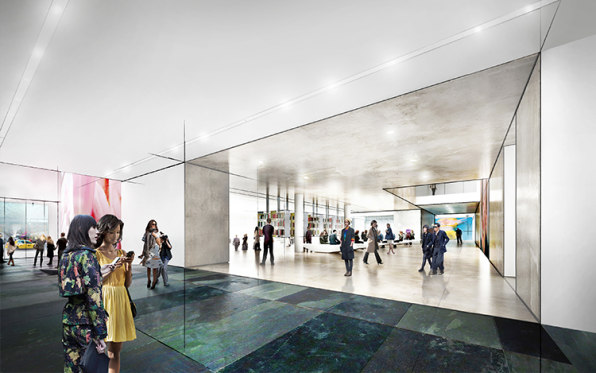BY: JENNIFER LEE
“If we valued fraternity as much as independence, and democracy as much as free enterprise, our zoning codes would not enforce the social isolation that plagues our modern neighbourhoods, but would require some form of public gathering place every block or two.” (Ray Oldenburg, The Great Good Place)
Think of the last museum you visited. Did everyone look comfortable, at ease? How quiet was it? Could you hear conversation? What about laughter? Did strangers strike up conversation with each other, or stick to their own groups? As financial and political pressures on the museum change, some museums are looking to become social ‘living rooms’ where visitors can meet and congregate. The phrase ‘third place’, taken from the vocabulary of urban planners and sociologists, is often thrown around in these discussions, conjuring up a picture of museums as shiny, Starbucks-like lounges full of happy millennials. Unsurprisingly, this is not a vision that everyone finds attractive. What do museums stand to gain – and lose – by pursuing the ideal of the third place?
“If we valued fraternity as much as independence, and democracy as much as free enterprise, our zoning codes would not enforce the social isolation that plagues our modern neighbourhoods, but would require some form of public gathering place every block or two.” (Ray Oldenburg, The Great Good Place)
Think of the last museum you visited. Did everyone look comfortable, at ease? How quiet was it? Could you hear conversation? What about laughter? Did strangers strike up conversation with each other, or stick to their own groups? As financial and political pressures on the museum change, some museums are looking to become social ‘living rooms’ where visitors can meet and congregate. The phrase ‘third place’, taken from the vocabulary of urban planners and sociologists, is often thrown around in these discussions, conjuring up a picture of museums as shiny, Starbucks-like lounges full of happy millennials. Unsurprisingly, this is not a vision that everyone finds attractive. What do museums stand to gain – and lose – by pursuing the ideal of the third place?
 |
| Millennials enjoy a relaxed third place. Laughter is an important element of social bonding. Source. |
The sociologist Ray Oldenburg defined the concept of the third place (or third space) in his book The Great Good Place, published in 1989. The first place, he theorized, is home, where our personal lives play out; the second place is work or school, where we live our professional lives. The third place is neither: it’s the neutral 'watering holes' such as coffee shops, bars, barber shops, parks, and other spaces between work and home where we congregate. The most important features of the third space are that they are accessible spaces open to everyone, and that they allow for shared social experience and the breaking-down of social boundaries. They are convivial and free: a remedy "for stress, loneliness, and alienation"(40).
Robert Putnam’s Bowling Alone: The Collapse and Revival of American Community (published 2000) complements Oldenburg’s work, tracing Americans’ increasing disengagement from public life and community structures (such as political parties, charities, and parent-teacher organizations) throughout the late 20th century. Putnam found widespread decline in what he called ‘social capital’ – Americans’ personal social networks were smaller and their sense of mutual trust, respect, and altruism had eroded over time. He also warned, presciently, that “if participation in political deliberation declines – if fewer and fewer voices engage in democratic debate – our politics will become more shrill and less balanced” (342). Part of the problem, he theorized, was mass media: the more time we spend watching television, the less time we spend engaging with our communities. (Reading this book seventeen years later, I have to wonder what Putnam makes of that 21st-century institution, the Netflix binge.)
One way to combat the death of social capital, of course, is through the third place: if people are given neutral spaces to socialize and get to know each other, to work through their differences, it follows that trust and respect will increase, residents will feel they have a stake in their communities, and civic engagement will follow. This is the thinking that leads some museums like MOMA and the Worcester Art Museum to pursue third-place-ness, hoping to bolster a sense of community and engagement - and tempt some new visitors into the museum.
 |
| A blind-date 'conversation meal' between strangers at the Oxford Museum of Natural History. Source. |
But by Oldenburg’s criteria, many museums don’t qualify as third places: in the still, hushed atmosphere of the average art gallery or history museum, complete with security guards, visitors rarely feel like they can let down their guard enough to engage in the kind of convivial, free discussion Oldenburg describes. Although museum cafes and atriums might have a lighter atmosphere, high entry fees, program registration fees, and membership costs may also present a barrier to those who can’t afford to attend regularly. Unfortunately, the success of a third place depends on regulars who create a shared culture and welcome newcomers. Many people, for reasons of class, race, or social and educational background, simply don’t feel comfortable walking into a museum, let alone visiting one regularly as a social event. Creating a third-place atmosphere could mean rolling back entrance fees and relaxing or changing our expectations of visitor behaviour, altering the atmosphere of the museum.
There’s also the problem of the art. When the Museum of Modern Art released their plans for an expansion in 2014, they were heavily criticized for the amount of room given to social and performance space, much of it accessible without paying an entrance fee. Vulture critic Jerry Saltz commented that the new space was designed “so people can look at other people looking at other people looking at people.” Surely the point of visiting a museum, the skeptics asked, was to look at the collections? In response, director Glenn Lowry defended the museum as a space of experience, reflection, and conversation. Creating a third place in the museum may contradict ideas (even among museum staff, and especially among visitors) of what a museum is and does: is it, as Saltz believes, primarily a space for people to look at art? Is it a community living room? Can it possibly be both?
 |
| Plan for the MOMA expansion by architectural firm Diller Scofidio + Renfro. Admittedly, there is a conspicuous lack of art in this art museum. Source. |
The truth, as usual, may lie somewhere in the middle. Museums certainly have a role to play in dialogue, engagement, and forming relationships – some particularly excellent programs rose in the wake of the U.S. election, like the National Civil Rights Museum's vow to engage in "difficult and uncomfortable" conversations with volunteers about prejudice and systemic inequality. As civic institutions, we can’t divorce ourselves from civic life and our communities. But we’re not Starbucks or a neighbourhood pub, and likely couldn’t be if we tried. As Nina Simon writes, “Museums are explicitly about something, and third places are about nothing in particular”. We may even do ourselves a disservice by competing with other public spaces as a watering hole rather than a repository of beauty and human knowledge (which is, after all, our great strength). Obviously, museums need to make themselves more accessible and encourage people outside of their traditional audience to visit – but in the interest of being a better museum rather than a third place.
Suggested Reading
Ferro, Shaunacy. “MOMA’s redesign won’t destroy the museum”. Co.Design. January 13, 2014. https://www.fastcodesign.com/3024679/momas-redesign-wont-destroy-the-museum
Freeman, Terri Lee. "Twentyseventeen." National Civil Rights Museum. http://www.civilrightsmuseum.org/news/posts/twentyseventeen
Oldenburg, Ray. 1991. ‘The Character of Third Places’. Reprinted in Common Ground? Readings and Reflections on Public Space, edited by Zachary P. Neal and Anthony M. Oren, 40-48. New York: Routledge.
The Project for Public Spaces. https://www.pps.org
Putnam, Robert. 2000. Bowling Alone: The Collapse and Revival of American Community. New York: Simon and Schuster.
Simon, Nina. 'The Great Good Place Book Discussion Part 1: Can Museums Be Third Places?' Museum 2.0. June 1, 2010. http://museumtwo.blogspot.ca/2010/06/great-good-place-book-discussion-part-1.html


No comments:
Post a Comment
Note: only a member of this blog may post a comment.